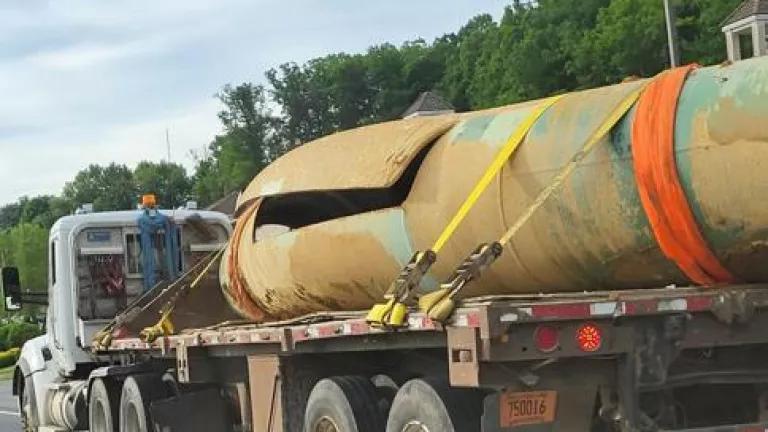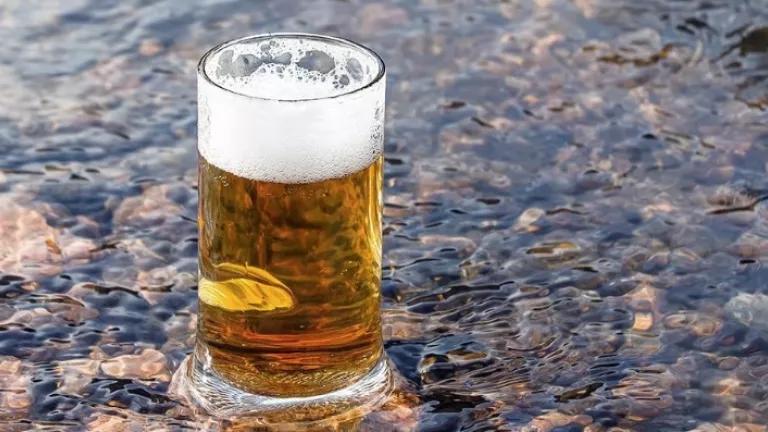
The Anacostia River has the dubious distinction of being one of the few waterways in the country that's legally designated as "impaired" by trash pollution. The river - which flows from Maryland, through the District, and eventually into the Potomac - is all too frequently littered with plastic bags, food wrappers, plastic bottles, and Styrofoam that are washed into its waters by stormwater pipes or dumped directly on its banks. All this trash harms wildlife and makes the river unsafe and unpleasant for recreational use.
Trash in the Anacostia. Photo credit: District Department of Energy & Environment
In 2010, Maryland and the District jointly developed a clean-up "blueprint" (in legal terms, a "total maximum daily load," or "TMDL") to serve as a framework for addressing the Anacostia's trash problem. The development of this plan served an important purpose, as it drew both attention and funding to the region's trash reduction efforts.
But in the past five years, it's become clear that the plan has fundamental flaws that are undermining the success of the program. NRDC identified some of these flaws back when the framework was being developed, while others have become evident over time.

The Anacostia watershed. Image credit: Anacostia Watershed Society
Here's the problem: "blueprints" like this one are supposed to set a maximum "load" (daily amount) of pollution that a waterway can handle and still be considered sufficiently clean and safe. But instead of establishing a maximum amount of trash that can be discharged to the Anacostia, this clean-up plan takes a different approach. It tells the three watershed jurisdictions - the District, Montgomery County, and Prince George's County - how much trash they must remove from the river, as calculated from the estimated baseline of present-day trash pollution. In theory, if the prescribed amount of trash is "removed," then the Anacostia will be trash-free.
What's wrong with this approach? It may seem like a reasonable strategy at first glance, but it has serious negative consequences. That's because in order for the removal-based approach to work, two things have to be 100% accurate.
The trash baseline
The first is the estimated baseline of how much trash is currently entering the river. Based on a limited number of surveys, the clean-up plan estimates that 455,648 pounds of trash enter the river every year (!). Therefore, it calls for 455,648 pounds to be removed from the river each year, with that total divided up amongst the three watershed jurisdictions. (Most of the trash comes from Prince George's County, so it's likewise responsible for removing the most trash.)
But what if 455,648 pounds is the wrong number? We could find ourselves in a situation where our local agencies are "removing" that many pounds of trash and fulfilling their obligations under the plan, but there's still garbage in the river. Of particular concern, the plan doesn't account for future increases in trash due to population growth in the watershed. That in itself is reason to doubt the accuracy of the baseline established in the plan.
In fact, an official from the Maryland Department of the Environment publicly agreed with this concern back when the clean-up plan was adopted.

Graphs showing the different types of trash commonly found in the Anacostia River and its tributary streams. Click to enlarge. Image credit: District Department of Energy & Environment
The formulas for estimating trash removal
The second thing that has to be accurate for the removal approach to work is the method for calculating how much trash is being "removed" by the different programs that local agencies are implementing.
In some parts of the watershed, like the river's mainstem in the District of Columbia, trash can be physically removed from the water and measured. But what happens when we enact policies to keep trash out of the river in the first place, such as by educating people about recycling, or charging a fee for plastic bags? How should this kind of "removal" be calculated? It's really hard to do.

A "trash trap" physically removing trash from the Anacostia, which is typically easier to measure than prevention-based programs. Photo credit: District Department of Energy & Environment
For example, Montgomery County's trash reduction plan estimates that its school-based anti-litter programs reduce trash from 12% of residential land use, based on an assumption that "half of residential land use is influenced by school age kids, effectiveness of messaging is 40% and willingness to participate is 60% or .5 x .4 x .6 = .12." The plan provides no explanation for how the county came up with those numbers. Prince George's County, in turn, estimates that its posting of "No Dumping" signs is 70% effective, based on a single statistic from Texas.
If these formulas are wrong, then we simply don't have any idea how much trash is being "removed" from the Anacostia. There's ample reason to believe not only that the current formulas are wrong, but that developing accurate formulas for many trash reduction practices is actually impossible.
Petitioning to fix the plan
It's time to change course. The removal-based approach is too difficult to implement and injects too much uncertainty into this hugely important effort. Fortunately, the solution is simple.
Today, a group of organizations, including NRDC, petitioned Maryland and the District of Columbia to revise the Anacostia trash clean-up plan so that it establishes a maximum trash load. This is what other clean-up "blueprints" do (after all, they're called "total maximum daily loads" for a reason), and what the Clean Water Act requires.
If we establish a maximum trash load (for example, zero pounds, or some other suitably small number developed through careful analysis), then there will be no need to measure "reductions" against an unreliable baseline. Instead, we can focus on measuring how much trash is actually in the river. In other words, making this change will allow us to start assessing progress based on real-world results.
Fixing the clean-up plan would have many benefits for the local agencies who are hard at work implementing trash reduction programs. Instead of dedicating all of their staff's time and effort to developing theoretical trash removal formulas, they can focus their attention on actually cleaning up trash. And they'd have greater certainty that their efforts will ultimately lead to a successful outcome.
Most importantly, establishing a stronger clean-up framework would also have huge benefits for the local families that use and enjoy the Anacostia River and want to see it live up to its true potential as a community resource. That's why two of our co-petitioners are groups representing those who use the river and its shores for recreation: Maryland Milestones/Anacostia Trails Heritage Area, which is dedicated to preserving and promoting the historical, artistic, cultural, and natural resources of the Anacostia Trails Heritage Area, and the Washington Rowing School, which offers rowers of all levels the opportunity to improve their skills while enjoying the beauty of the Anacostia.
The time is right for making this change. The plan is already being used as a model in other places whose waterways are polluted by trash, including Baltimore. We should correct the flaws in the plan before they're replicated in even more watersheds.
We're hopeful that our petition marks the start of a collaborative effort that will result in a stronger clean-up framework for our region. We all deserve to have confidence that at the end of this process, we will have achieved an Anacostia River that's free of trash - a clean and safe environment for all residents of the capital region to use and enjoy.

Local schoolkids canoeing on the Anacostia. Photo credit: the White House



